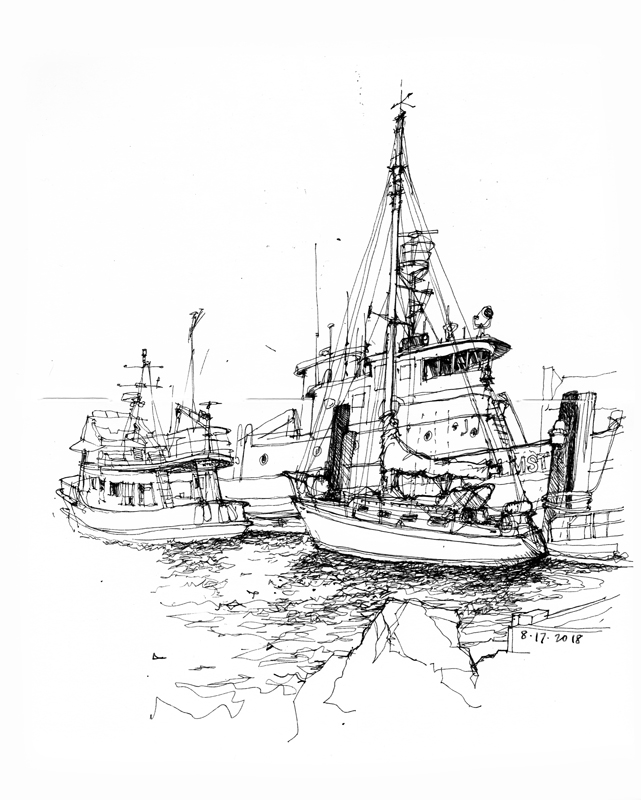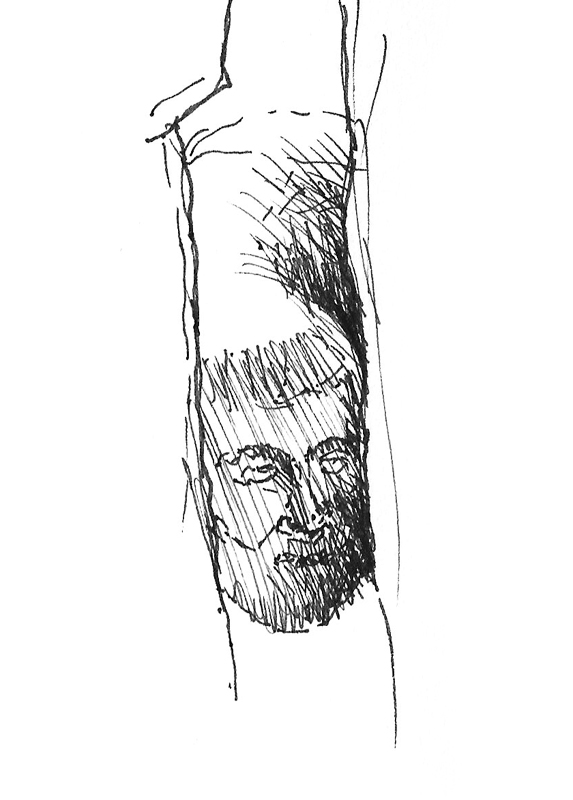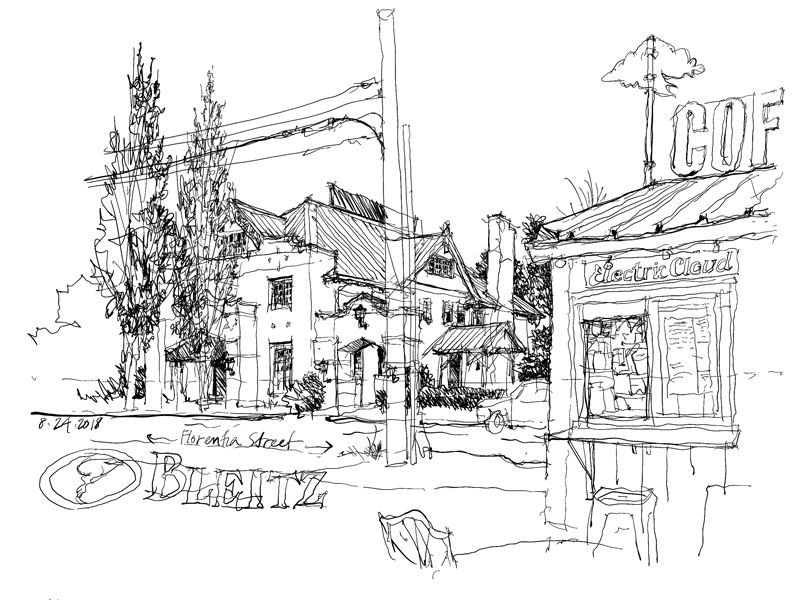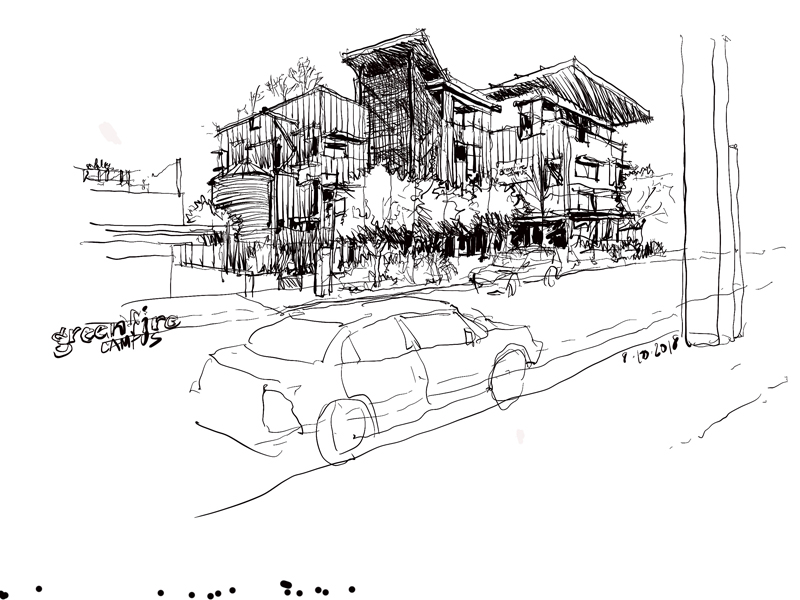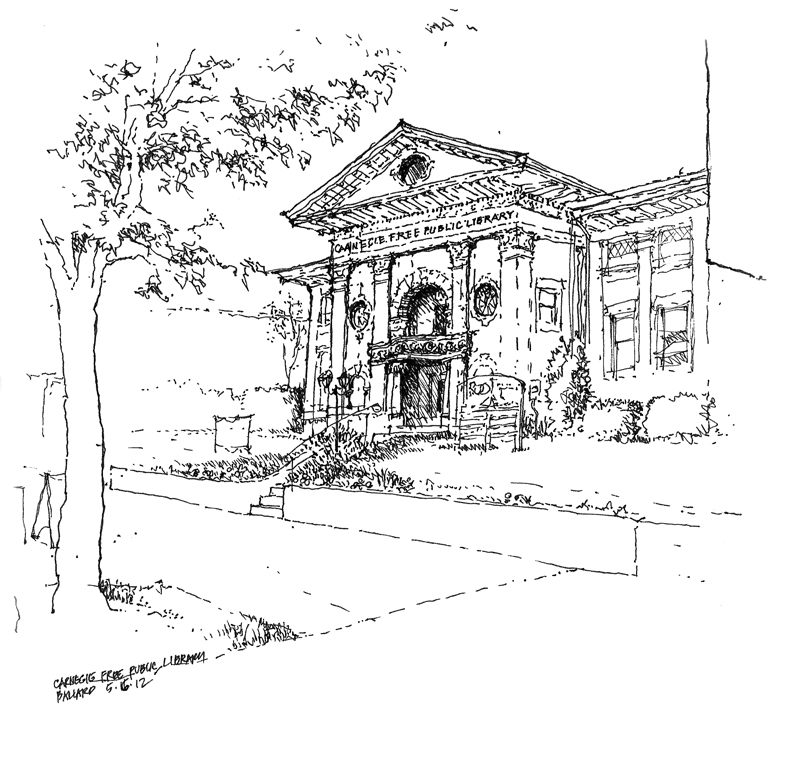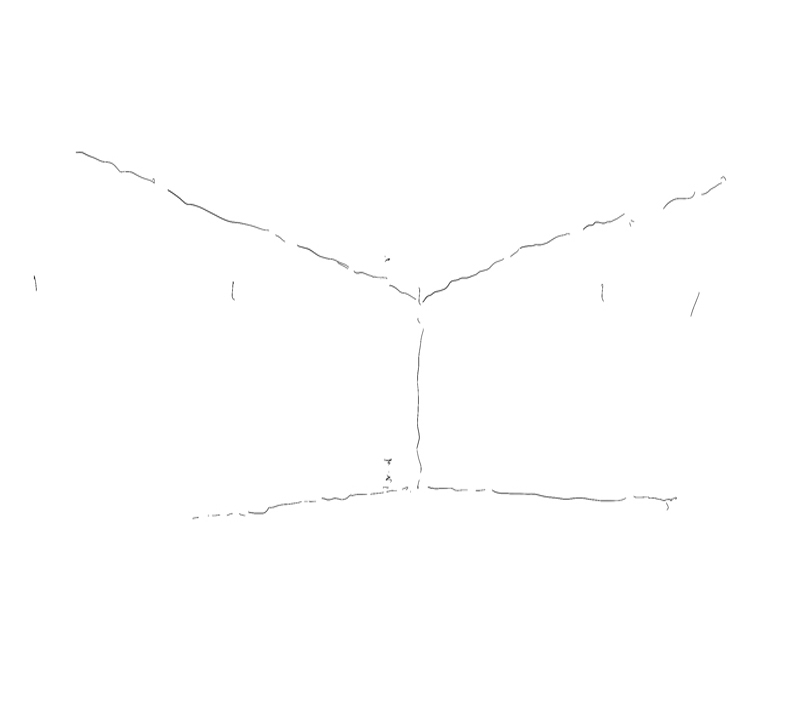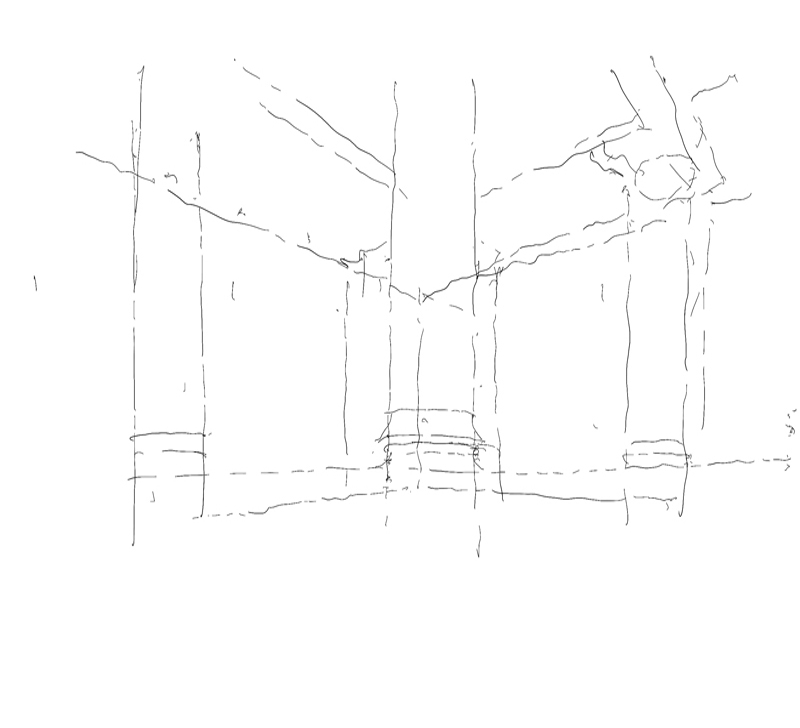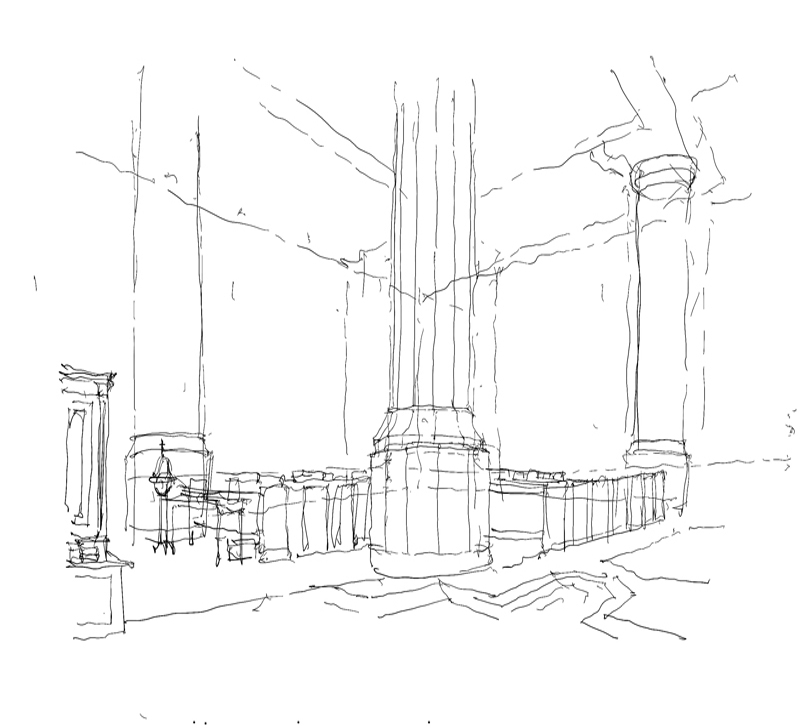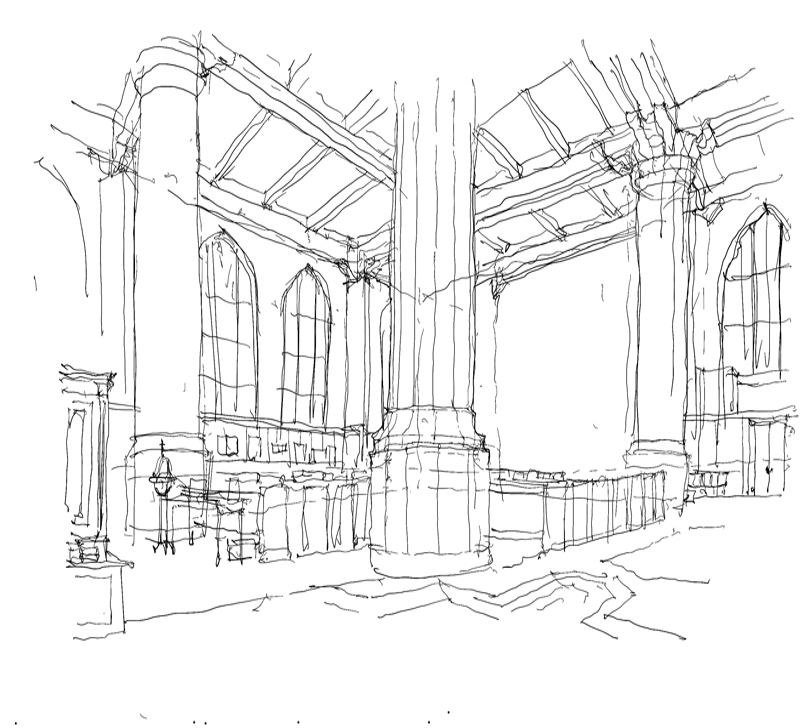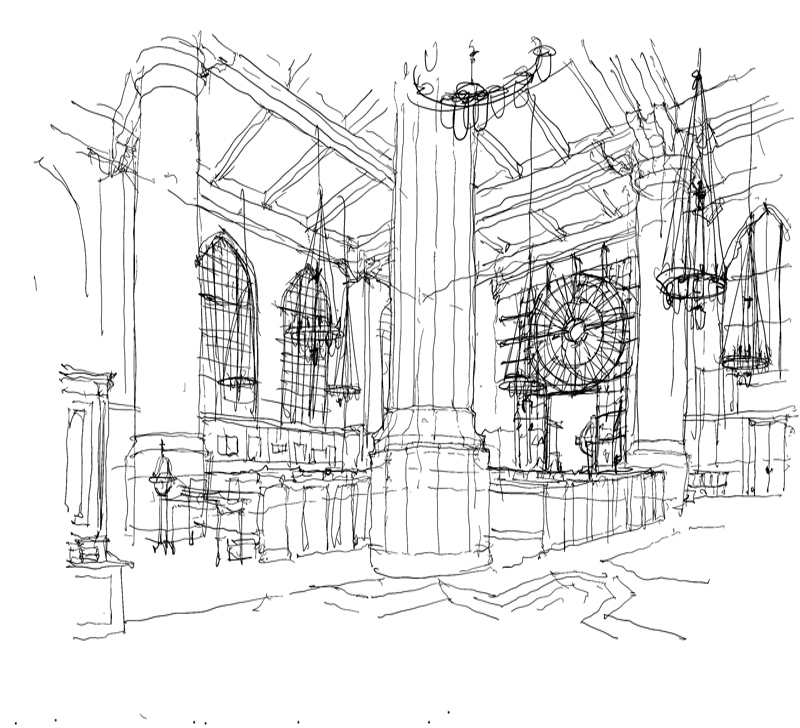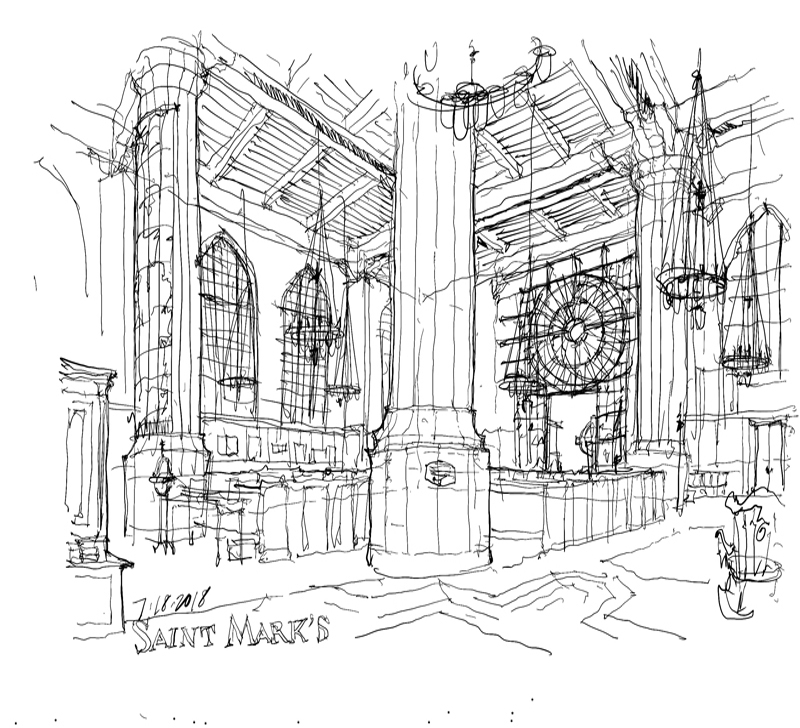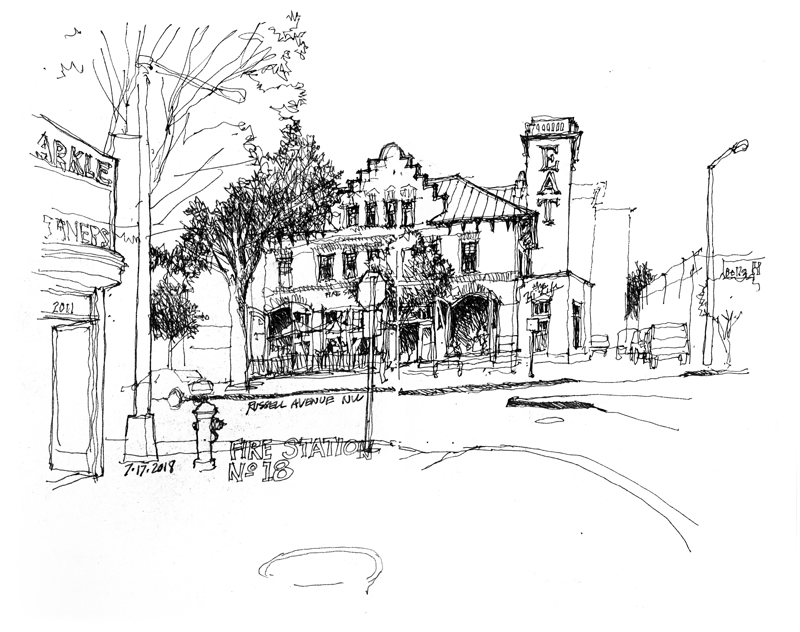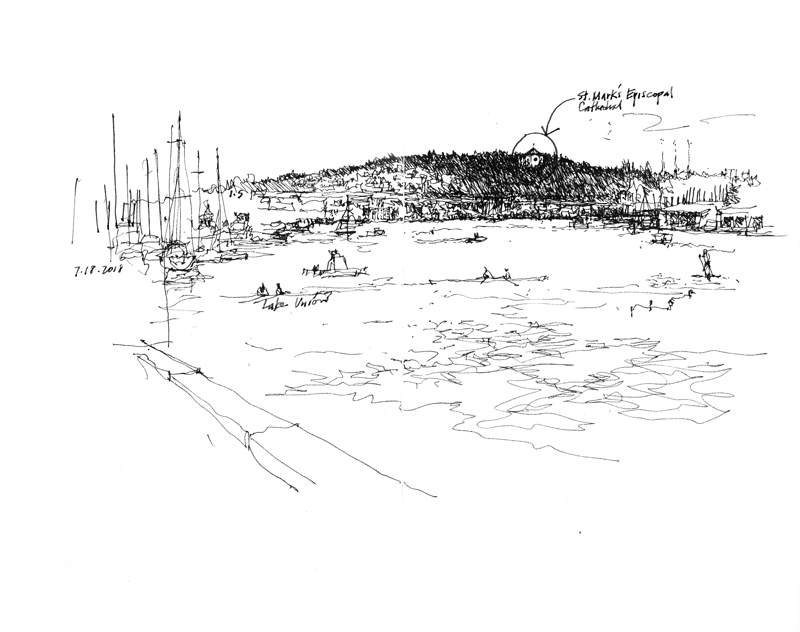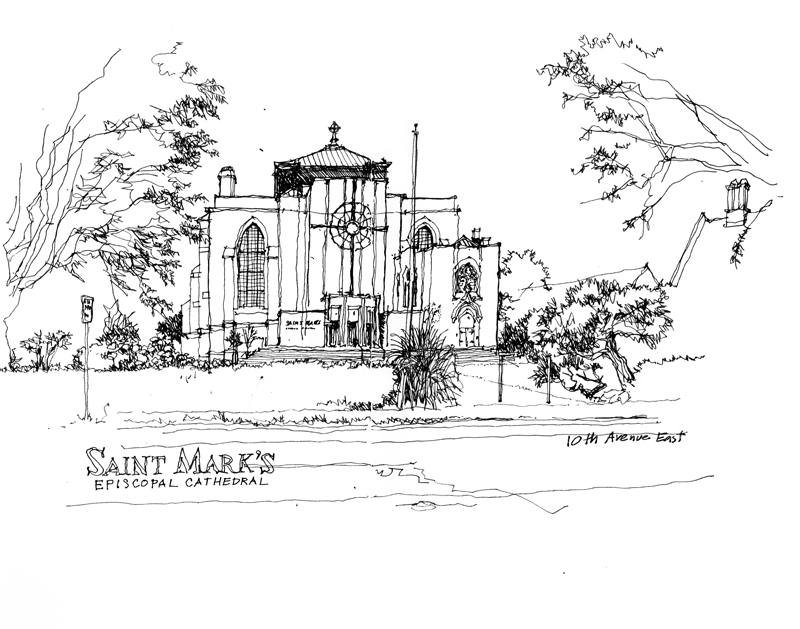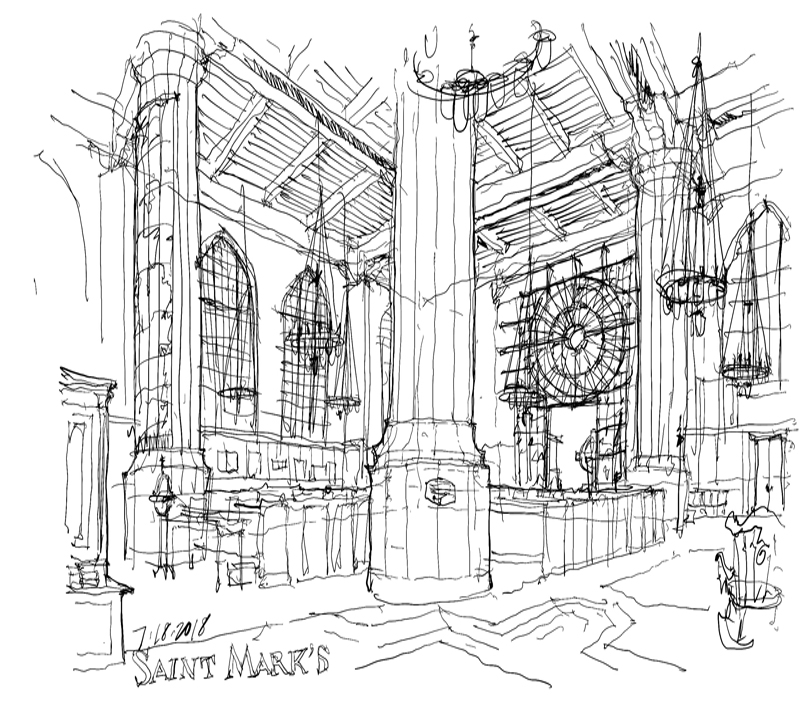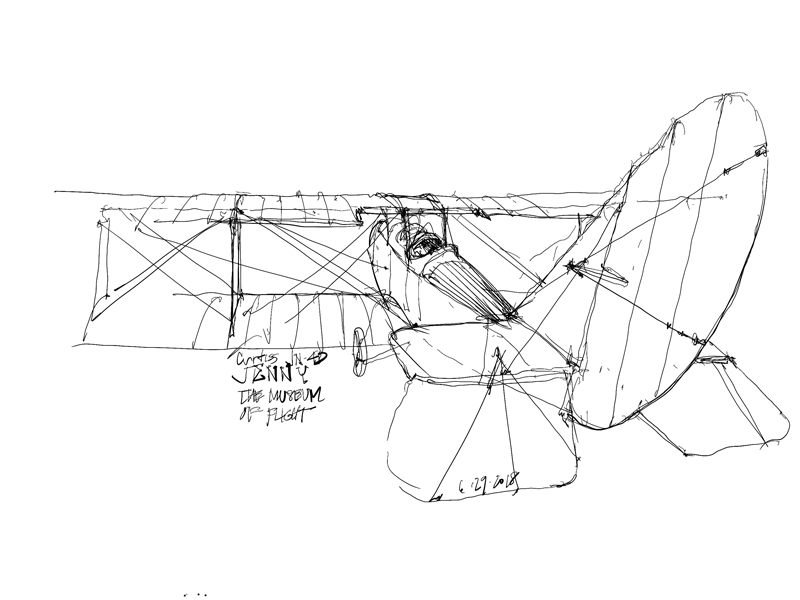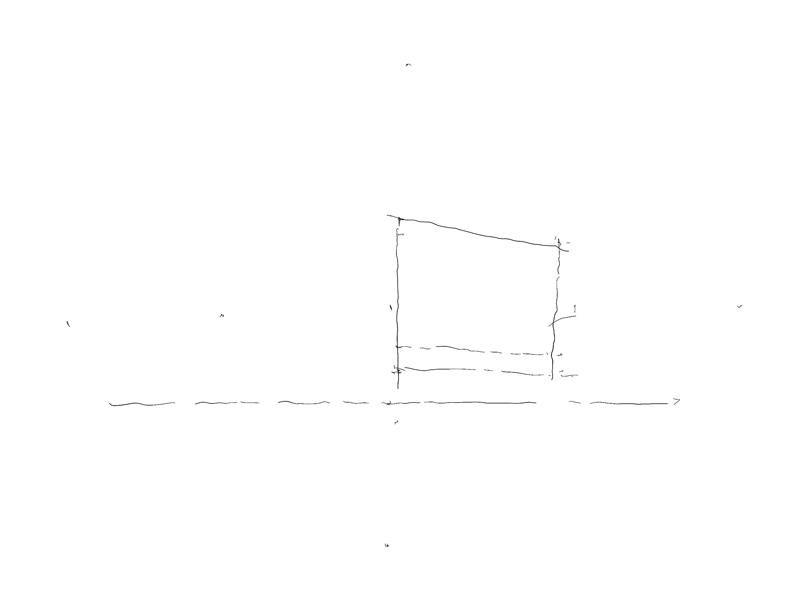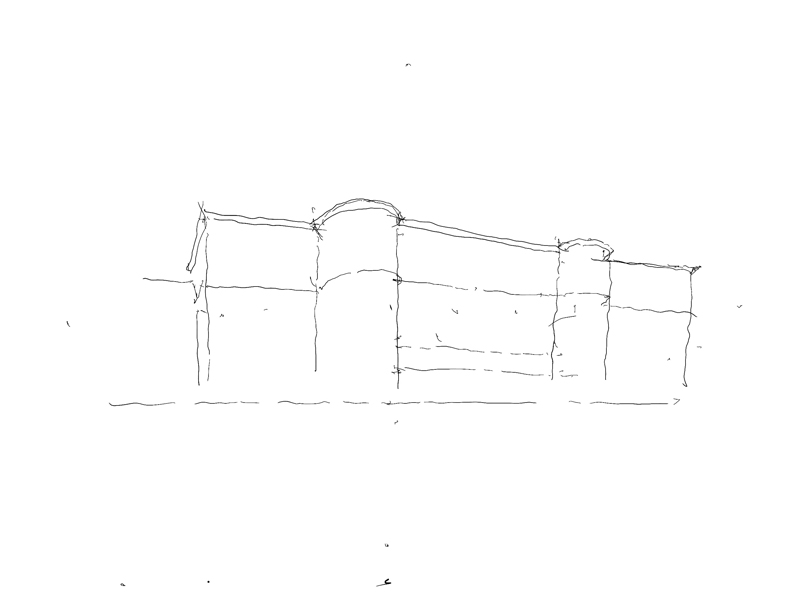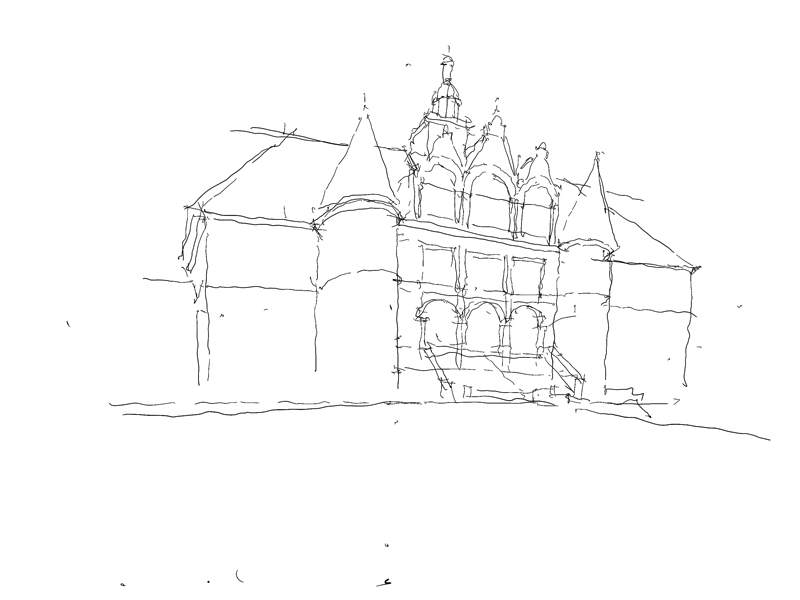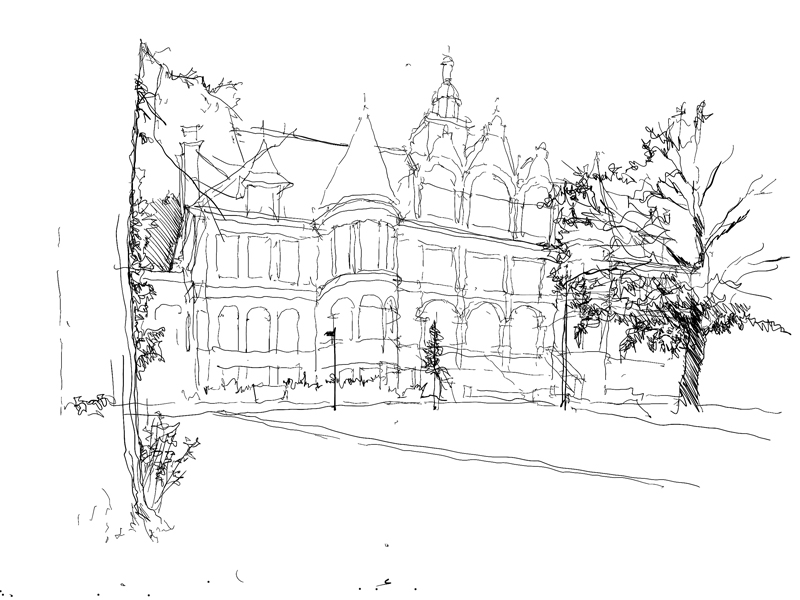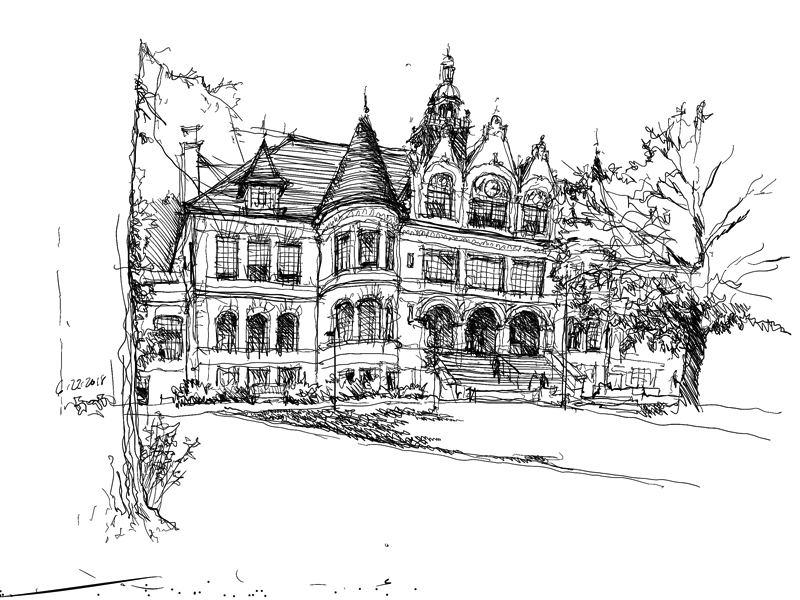Simply a view from where 28th Avenue NW ends just beyond NW 54th Street, offering public access to Salmon Bay.
Waiting for the Interurban
This cast-aluminum sculpture by Richard Beyer is another Fremont landmark at the corner of North 34th Street and Fremont Avenue North, at the east end of the Fremont Bridge. Erected in 1978, it depicts five people waiting for the Seattle-Everett light rail line. Not shown in this view but included among the figures is a sixth (shown below), that of a dog with a face that resembles Armen “Napoleon” Stepanian, the unofficial Mayor of Fremont in her early days and with whom Beyer is supposed to have had several disagreements. The figures are often dressed by local residents in costumes appropriate to the season or to celebrate birthdays, weddings, even political events.
Bleitz Funeral Home
In 1904, Jacob J. Bleitz established Bleitz Funeral Home. In 1921, Bleitz had this structure built southeast of the Fremont Bridge, across the Ship Canal from the Fremont neighborhood.
The city of Seattle Landmarks Preservation Board designated the Bleitz Funeral Home a city of Seattle landmark early last year. In the landmark nomination application, architect Susan D. Boyle wrote of the building’s eclectic style: “The original two-and-a-half story funeral home is a combination of a vernacular building with an eclectic revival style front facade. It appears to have been the work of a designer, although the identities of the original designer or architect and builder remain unknown, and no original design drawings have been discovered.”
While the concrete exterior still stands, most of the interior has been gutted in preparation for its conversion into office spaces for small to mid-size companies.
Here is a brief video clip of my drawing process.
Greenfire Campus
Adjacent to Ballard Branch Library No. 3 is the Greenfire Campus, a two-building complex comprising apartments, offices, and a restaurant. Johnston Architects designed the campus with two ideas in mind: “sensible sustainability and social sustainability.” The first refers to the goal of balancing cost and performance while employing active and passive methods for heating, cooling, and daylighting; saving and filtering water for reuse; and wrapping interior spaces with an energy-efficient envelope.
The second idea explores the means to enhance the interaction between human activities and the natural environment can, including building in the sharing of amenities and providing for areas devoted to urban agriculture.
Here is a brief video clip of my drawing process.
Ballard Branch Library No. 3
This is Ballard Branch Library No. 3, at the corner of NW 57th Street and 22nd Avenue NW. The library was designed by Bohlen, Cywinski, Jackson to incorporate community meeting rooms as well as a neighborhood center providing services for veterans and employment assistance. Construction on the library began in February 2004 and it was opened to the public in May 2005.
This building replaced the now demolished Ballard Branch Library No. 2, which itself replaced the 1904 Carnegie Free Library in Ballard, which I drew six years ago.
International Left Handers Day
To mark International Left Handers Day, which celebrates the “uniqueness and differences” of left handers in a predominantly right-handed world, here is a sequence of six drawings showing how I constructed the interior view of St. Mark’s Episcopal Cathedral I posted a couple of weeks ago. I first established a corner where two adjoining planes meet, and transformed these planes into a volume with the addition of four columns. Then, over this 3D framework, I developed the details on the columns, pews, windows, ceiling patterns, light fixtures, and sanctuary.
Historic Firehouse No. 18
When drawing in an urban setting, there is often a degree of tension between including the context for a building in a wide-angle view and capturing the character of a building up close. Here are two drawings of Seattle’s Firehouse No. 18 that illustrate these two points of view.
Designed by Bebb & Mendel for housing horse-drawn fire engines and built in 1911, Firehouse No. 18 was in continuous use for 63 years. After it was declared surplus property by the City of Seattle, it was acquired by Historic Seattle, which holds a preservation easement on the property. A designated Seattle Landmark and listed in the National Register of Historic Places, the old firehouse is now home to the Hi-Life Restaurant.
St. Mark’s Episcopal Cathedral
Founded in 1889, St. Mark’s eventually outgrew its first two churches in downtown Seattle and on First Hill. So in 1926, plans were drawn up for a larger facility on Capitol Hill, on its present site overlooking Lake Union. It remains a Seattle landmark that can be seen from the west along the tree-lined ridge of north Capitol Hill.
Because of the Stock Market Crash of 1929 and the subsequent Great Depression, an incomplete cathedral was dedicated in 1931. And after a St. Louis bank foreclosed on the mortgage in 1941, the empty structure was used by the U.S. Army during WWII as an anti-aircraft gun training center. After the war, fundraising helped erase St. Mark’s debt and on Palm Sunday 1947, the mortgage was burned before the parish in front of the Altar.
What we see now is the result of a series of renovations and additions over the years, the latest of which is a redesign of the sanctuary by Olson Sundberg featuring a glass and steel screen by northwest artist Ed Carpenter.
Historic Planes
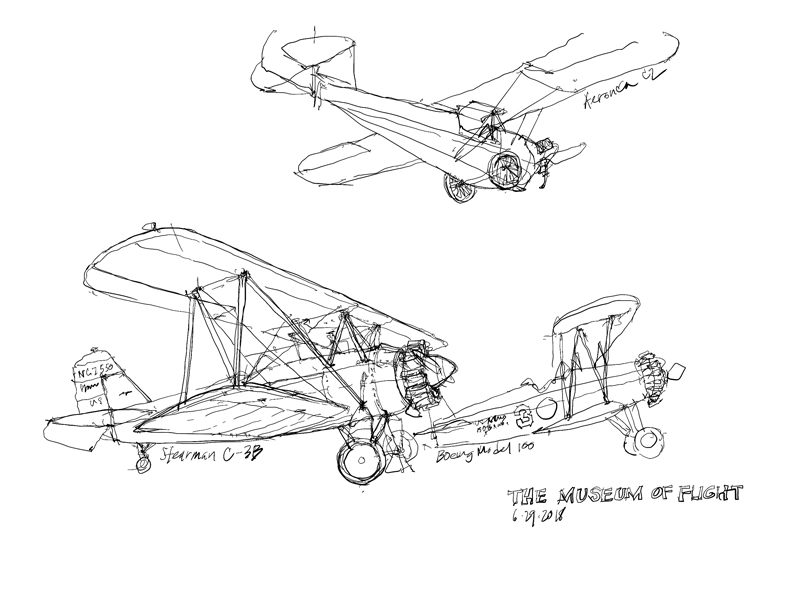 These are just a few of the incredible collection of historic planes at the Museum of Flight, which touts itself as “the largest independent, nonprofit air and space museum in the world.” The first sketch is of the Stearman C-3B, Boeing Model 100, and Aernoica C2. The second is a Vietnam-era McDonnell F4C Phantom II, and the third is a very foreshortened view of the Curtiss JN-4D “Jenny.”
These are just a few of the incredible collection of historic planes at the Museum of Flight, which touts itself as “the largest independent, nonprofit air and space museum in the world.” The first sketch is of the Stearman C-3B, Boeing Model 100, and Aernoica C2. The second is a Vietnam-era McDonnell F4C Phantom II, and the third is a very foreshortened view of the Curtiss JN-4D “Jenny.”
In each view, I started with the aspect of the longitudinal axis of each plane before building up the three-dimensional form of the fuselage and wing structures along this axis. A major difficulty in drawing these views is being able to capture how much the fuselages and wing structures are foreshortened. Below is a short video clip showing this process.
Denny Hall
The cornerstone for Denny Hall, the first structure to be built on the University of Washington campus, was laid on July 4, 1894. Designed by Charles W. Saunders, the four-story edifice contained a library, museum, music room, faculty offices, student lounge, six laboratories, and a 700-seat lecture hall. Originally called the Administration Building, it was renamed Denny Hall in 1910, after Arthur Armstrong Denny, one of the founders of the city of Seattle.
I intended these views of Denny Hall to be a lesson in composing and beginning a drawing—first framing the view, establishing a vertical measuring line, sizing and placing a major plane, and then roughing out the overall structure before developing the details.

